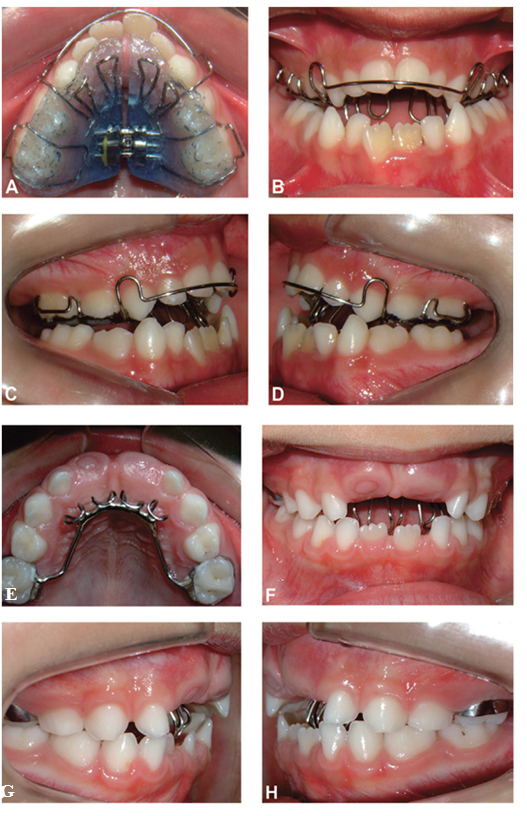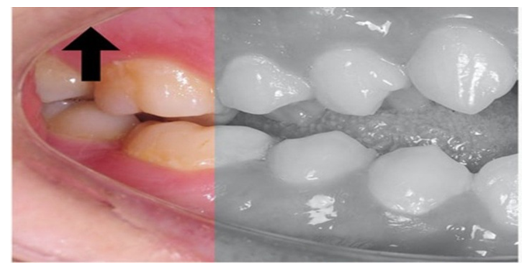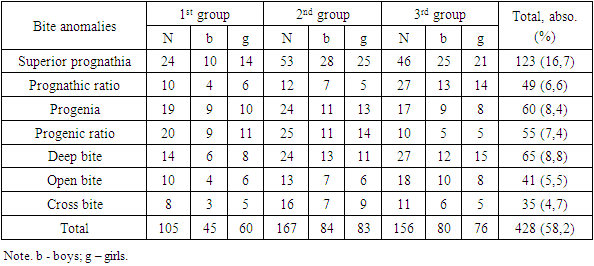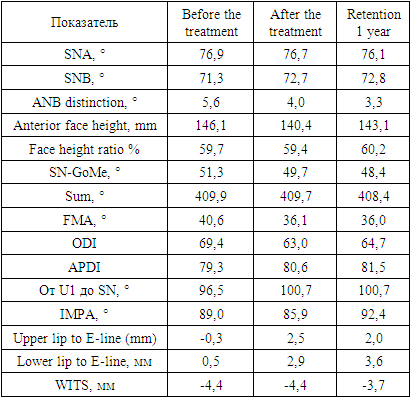-
Paper Information
- Next Paper
- Previous Paper
- Paper Submission
-
Journal Information
- About This Journal
- Editorial Board
- Current Issue
- Archive
- Author Guidelines
- Contact Us
American Journal of Medicine and Medical Sciences
p-ISSN: 2165-901X e-ISSN: 2165-9036
2022; 12(12): 1261-1266
doi:10.5923/j.ajmms.20221212.19
Received: Nov. 22, 2022; Accepted: Dec. 5, 2022; Published: Dec. 14, 2022

Employment of Microimplants in Orthodontic Treatment of Open Bite with Speech Disturbance
Nigmatov Rakhmatilla Nigmatovich1, Nigmatova Iroda Maratovna2, Shamukhamedova Feruza Abdulkhakovna3, Nodirhonnova Malika Orifhon Qizi3, Qodirov Jasur Mavjudovich3
1Department of Orthodontics and Dental Prosthetics, Doctor of Medical Sciences, Tashkent State Dental Institute, Tashkent, Uzbekistan
2Doctor of Philosophy (PhD) in Medical Sciences, Director of the Master's Program at the Department of Orthodontics and Dental Prosthetics of the Tashkent State Dental Institute, Tashkent, Uzbekistan
3Department of Orthodontics and Dental Prosthetics of Tashkent State Dental Institute, Tashkent, Uzbekistan
Copyright © 2022 The Author(s). Published by Scientific & Academic Publishing.
This work is licensed under the Creative Commons Attribution International License (CC BY).
http://creativecommons.org/licenses/by/4.0/

Purpose: Substantiation of the use of microimplants in the correction of open bite by intrusion of the chewing teeth. Material and methods: a mass dental examination was carried out in 735 patients (of which 342 boys and 393 girls) in the period of mixed dentition at the age of 6 to 14 years, of which 505 were children attending the school educational institution school No. 18 in Tashkent, as well as 230 adult patients who applied to the clinic of Orthodontics of the Tashkent State Institute at the age of 16-30 years. All examined patients were conditionally divided into 3 groups depending on the occlusion: 1st - milk and early removable dentition (6-9 years), 2nd - late removable dentition (10-14 years) and 3rd - permanent bite. Results: 41 patients with open bite and speech disorders underwent a complex of diagnostic and therapeutic measures. These patients were advised to wear the Infant and T4K trainers. Vestibular plates were also fabricated with an expanding screw, a vestibular arch, and a tongue grille. The use of the trainer Infant in the complex orthodontic and speech therapy practice gave good efficiency only in the milk occlusion. In children over 5 years of age, positive effects have been obtained from the use of the T4K trainer. The examined patients with permanent occlusion underwent orthodontic treatment using microimplants for intrusion of the posterior teeth. After treatment, the patient had a normal bite (1.5 mm) to overlap (2.5 mm) ratio, stable occlusion, class I canine to molar ratio, and a correct midline. Conclusions: in order to achieve a good result with the help of trainers and orthodontic plates, a great cooperation with the patient is necessary, which is expressed in conscientious wearing of the devices in compliance with personal oral hygiene. In permanent occlusion patients, appliances do not need to be attached to the anterior segment during intrusion, allowing for more esthetic treatment. Although micro-implant molar intrusion is an effective method for correcting open bite, it is not a universal method for all types of open bite.
Keywords: Teeth, Dentition, Open bite, Orthodontic apparatus, Trainers, Orthodontic plate, Microimplant, Intrusion, Speech disorder, Speech correction
Cite this paper: Nigmatov Rakhmatilla Nigmatovich, Nigmatova Iroda Maratovna, Shamukhamedova Feruza Abdulkhakovna, Nodirhonnova Malika Orifhon Qizi, Qodirov Jasur Mavjudovich, Employment of Microimplants in Orthodontic Treatment of Open Bite with Speech Disturbance, American Journal of Medicine and Medical Sciences, Vol. 12 No. 12, 2022, pp. 1261-1266. doi: 10.5923/j.ajmms.20221212.19.
Article Outline
1. Introduction
- Open bite is considered one of the most difficult disorders to treat in orthodontics. Over the past 10-15 years, the number of children in whom the habitual open position of the mouth has been fixed has increased, resulting in a restructuring of the type of breathing: the child switches from the physiological nasal type of breathing to the pathological oral type of breathing, as a result, a pathological open bite is formed.This non-physiological open position of the mouth may be facilitated by the pathology of the ENT organs. (ear, throat, nose), causing the pathological process of nasal breathing. Children, the incidence of adenoids and chronic rhinitis, secondary disorders occur, are found in reduced phonemic hearing. Deterioration of auditory perception and auditory differentiations slows down the process of formation of language means and entails speech disorders. The consequence of a violation of phonemic hearing may be a general underdevelopment of speech, a violation of the intonational expressiveness of speech, etc.Due to the constantly open mouth, the labial muscles become flaccid. Low tone of the circular muscle of the mouth makes it difficult for the lips to close normally, interfering with the normal development of the lower jaw. In speech, there is insufficient labialization (active participation of the lips in pronouncing sounds), especially vowels. Later, at school age, insufficient labialization of vowels can lead to specific (speech) errors in writing.Based on the foregoing, the incorrect structure of the articulatory apparatus and malocclusion is one of the most common causes of deficiencies in sound pronunciation. Anomalies and deformities of the maxillofacial region prevent the normal articulation of sounds, contribute to the consolidation of the habits of incorrect articulation and make it difficult to correct them (Ayupova F. S. Voskanyan A. R., 2016).The literature describes dentoalveolar anomalies resulting from mesial displacement of the posterior teeth and methods for their treatment (Korkhaus, 1939; Oppenheim, 1934; Schwarz, 1962; Mejer, I968, etc.). However, the biomechanical principles of the distal movement of the lateral teeth (molars and premolars) and the indications for the use of one or another design of the orthodontic appliance have not been studied enough.To prevent complications and increase the effectiveness of treatment, it is proposed to strengthen the support by means of various variants of skeletal anchorage. Various anterior open bite treatments have been proposed to traditional orthodontic treatment, such as extrusion of anterior teeth using intermaxillary elastics; straightening molars with multi-loop edge archwire (MEAW) and inhibiting molars eruption during growth. However, none of these methods is satisfactory due to adverse effects on the skeletal, aesthetic structure and a strong tendency to relapse.Another treatment option is to reposition both the maxilla and mandible through surgical correction. Although satisfactory results can be achieved with orthognathic surgery, the complexity, risks, and cost of the operation have initiated a search for alternative treatments.With absolute intrusion of the posterior teeth, autorotation of the lower jaw in the closing direction counterclockwise, closure of the open bite and reduction in the height of the anterior face without surgical intervention is possible. Intrusion has been reported to provide a more consistent treatment outcome than extrusion. Because the propensity to relapse is higher in adults, it is important to choose both a stable and predictable treatment.This can be achieved with temporary anchoring devices such as osseointegrated implants, miniplates, and microimplants. Microimplants have many advantages over various other temporary fixators (Jae-Hyun Sung, 2006).
2. Purpose of the Study
- Rationale for the use of microimplants in orthodontic treatment of open bite with speech impairment.
3. Material and Methods
- We conducted a mass dental examination of 735 patients (including 342 boys and 393 girls) in the period of mixed dentition at the age of 6 to 14 years, including 505 children attending school educational institution school No. 18 in Tashkent, as well as 230 adult patients who applied to the clinic of Orthodontics of the Tashkent State Institute at the age of 16-30 years. All examined patients were conditionally divided into 3 groups depending on the occlusion: 1st - deciduous and early removable dentition (6-9 years), 2nd - late removable dentition (10-14 years) and 3rd - permanent bite.Diagnosis of anomalies of teeth, dentition and occlusion was carried out on the basis of an anamnesis, the results of a clinical examination, an anthropometric study of the dentoalveolar system (DAS), TRG and orthopantomography of the jaws, and a biometric study of diagnostic models of the jaws.All examined, depending on the state of hard and soft tissues of the oral cavity and the presence of speech defects, the degree of nasal breathing disorders, were referred for consultation and treatment to the relevant specialists.
4. Research Results
- As a result of clinical and additional studies, out of 735 examined, malocclusion was detected in 428 (58.2%). Prognathic occlusion was diagnosed in 123 (16.7%) examined patients, of which 24 (3.26%) of the 1st, 53 (7.21%) of the 2nd and 46 (6.25%) of the 3rd group. Deep bite was observed in 65 (8.84%) examined, that is, respectively, in 14 (1.90%), 24 (3.26%) and 27 (3.67%) patients. Progenic occlusion occurred in 60 (8.16%) examined patients, including 19 (2.58%), 24 (3.26%) and 17 (2.31%) 1st, 2nd and 3rd group. Open bite was detected in 41 (5.57%) examined patients, of which 10 (1.36%), 13 (1.76%) and 18 (2.44%), respectively, from the 1st, 2nd and 3rd groups (Table 1).
|
 | Figure 1. Trainer "Infant" for milk bite (a); trainer T4K - for mixed dentition (b) |
 | Figure 2. Plates with an expansion screw, with a lattice for the tongue and occlusal linings in the area of the chewing teeth |
 | Figure 3. Photograph of patient M.K., 28 years old, before treatment |
 | Figure 4. Two different occlusal planes |
|
5. Progress of Orthodontic Treatment
- The patient required an extension of the upper jaw. Therefore, the rapid maxillary expansion apparatus (RME) was used for the first time. After sufficient expansion, microimplants 2 mm in diameter and 8 mm in length were placed on the buccal alveolar bone between the first and second premolars, between the second premolar and first molar, and between the first molar and second molar. The RME was kept as a palatal splint to prevent buccal tipping of the posterior teeth while an intrusive force was applied to the buccal side. Elastomeric chains were used to apply the intrusion force, the magnitude of the force was approximately 150-200 g per tooth (Fig. 5, 6). Molar intrusion was performed 5 months later and the anterior open bite was corrected.
 | Figure 5. Before and after open bite treatment |
 | Figure 6. Posterior segmental intrusion |
6. Conclusions
- 1. The use of the trainer "Infant" in complex orthodontic and speech therapy practice is effective only in patients in the period of milk occlusion. In children older than 5 years, a positive result was obtained from the use of the T4K trainer.2. The younger the child with an open bite and speech impairment, the better it responds to treatment, and the results obtained are stable.3. Microimplants are relatively simple and easy to insert, less traumatic, stable at optimal force, and allow force to be applied immediately after insertion. Other benefits include fewer restrictions at the implant site and lower costs.The use of a posterior segmental intrusion has advantages in both efficiency and esthetics. If intrusion is performed using the continuous wire technique, undesirable tooth movement will occur as well as posterior intrusion. Splinting the posterior segment allows for a more direct and efficient force. Appliances do not need to be attached to the anterior segment during intrusion, allowing for more aesthetic treatment.4. While micro-implant molar intrusion is an effective method for correcting open bite, it is not universal for all types of open bite.
 Abstract
Abstract Reference
Reference Full-Text PDF
Full-Text PDF Full-text HTML
Full-text HTML
